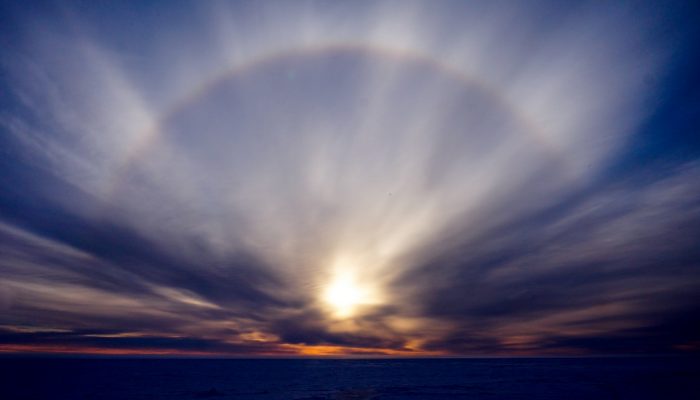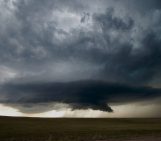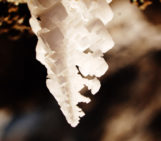
One of the main perks of being a geoscientist is that, often, research takes scientists all around the globe to conduct their work. While fieldwork can be hard and challenging it also offers the opportunity to see stunning landscapes and experiencing unusual phenomenon. Aboard the Akademik Tryoshnikov research vessel, while cruising the Kara Sea (part of the Arctic Ocean north of Siberia) Tatiana Matveeva was witness to an interesting optical phenomenon, a halo. In today’s post she tells us more about how the elusive halos form and how best to spot them.
It was one of many mornings on the Kara Sea, but the sunrise was very unusual – we saw halo. Because more often than not, the skies over the Arctic seas are covered in cloud, we were very lucky to see a halo!
Halos are produced by ice crystals trapped in thin and wispy cirrus or cirrostratus clouds, which form high (5–10 km) in the upper troposphere. The hexagon ice crystals behave like prisms and mirrors, refracting and reflecting sunlight between their faces, sending shafts of light in different directions.
Halos can have many forms, ranging from colored or white rings to arcs in the sky. The particular shape and orientation of the ice crystals is responsible for the type of halo observed. For example, halos may be due to the refraction of light that passes through the crystals or the reflection of light from crystal faces or a combination of both effects. Refraction effects give rise to colour separation because of the slightly different bending of the different colours composing the incident light as it passes through the crystals. On the other hand, reflection phenomena are whiteish in colour, because the incident light is not broken up into its component colours, each wavelength being reflected at the same angle. The most common halo is circular halo (sometimes called 22° halo) with the Sun or Moon at its centre. The order of coloration is red on the inside and blue on the outside, you can see it in this picture.
Historically, halos were used as an empirical means of weather forecasting before meteorology was developed.
Anecdotally, in the Anglo-Cornish dialect of English, a halo around the Sun or the Moon is called a ‘cock’s eye’ and is a token of bad weather. The term is related to the Breton word kog-heol (sun cock) which has the same meaning. In Nepal, a halo around the sun is called Indrasabha – the Hindu god of lightning, thunder and rain.
To see a halo, don’t look directly into the sun. Block the sun from your view with your hand, so you can just see the clouds around it. And enjoy beautiful optical phenomenon!
By Tatiana Matveeva, researcher at the Moscow State University
Imaggeo is the EGU’s online open access geosciences image repository. All geoscientists (and others) can submit their photographs and videos to this repository and, since it is open access, these images can be used for free by scientists for their presentations or publications, by educators and the general public, and some images can even be used freely for commercial purposes. Photographers also retain full rights of use, as Imaggeo images are licensed and distributed by the EGU under a Creative Commons licence. Submit your photos at http://imaggeo.egu.eu/upload/.


